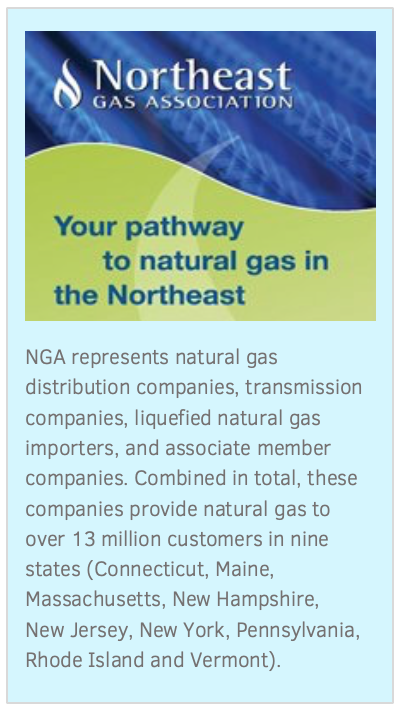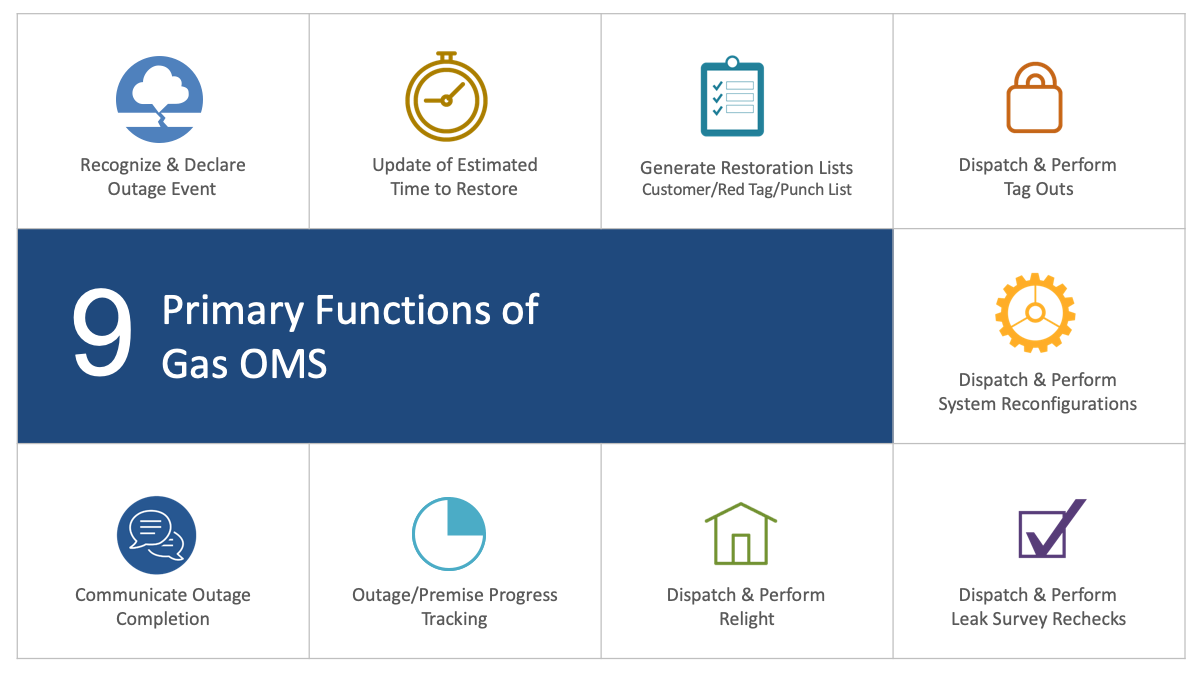The Northeast Gas Association (NGA) and its members are leading the charge for developing the Industry’s first complete Gas Outage Management System solution automating gas outage management and communications. UDC is pleased to share their story in the following article written by Dan Dessanti, NGA Director, Operations Services. Dan discusses what led to the organization’s decision to champion the solution, the development process and the NGA’s vision for Gas OMS in the future.
Content Overview
Natural Events Leading to Gas OMS
In the last decade and a half, severe storms have brought devastation to coastal areas and river communities throughout the U.S. with a range of impacts to human health and infrastructure, from Hurricane Katrina in 2005 and Superstorm Sandy in 2012 to Harvey, Irma and Maria in 2017. One of the major impacts of these events has been flooding, and one of the major impacts of flooding has been on local natural gas utility distribution systems.
Natural gas utilities in the Northeast have always had to deal with storm and water impacts, but the last few years in particular have brought a series of high-impact storms that has elevated concern over utility system security.
- In August 2011, Hurricane/Tropical Storm Irene brought flash flooding to eastern New York State, western Massachusetts and southwestern Vermont.
- About a week later, in early September 2011, Tropical Storm Lee also hit New York State and parts of New England, with repeated devastating results.
Through NGA, the utilities in the nine-state region of New York, New Jersey, Pennsylvania, and New England have conducted annual mutual aid planning to build a foundation for coordinating emergency response to situations such as flooding. As one example of that type of planning, NGA, in conjunction with the Southern Gas Association and the American Gas Association, organized a major workshop on flood emergency planning for New Jersey scheduled for mid-November 2012. However, that workshop had to be rescheduled when Superstorm Sandy barreled into the region in late October 2012 (the workshop was later held in March 2013.)
Superstorm Sandy made landfall in southern New Jersey, with impacts felt across more than a dozen states along the East Coast, particularly the densely-populated New York and New Jersey coasts, with heavy rain, strong winds, and record storm surges. During Sandy’s immediate aftermath, more than 8.5 million customers lost electricity. Approximately 240,000 natural gas customers were impacted.

Recognizing the Time is Now
There are several important areas gas companies need to address in order to prepare for an oncoming weather event. The primary areas of focus are:
- Incident Command System
- Resource Allotment
- Formalized Response Planning
- Tracking Impacted Customers
- Customer Communications
Although system-wide automated electric service outage systems have been successfully implemented by many electric utility operators to address such areas, their use by gas operators has been limited.
Making the industry keenly aware of the consequences of not having such a system, several major outage events in the northeast following Sandy have compounded interest in gas outage automation. More recently, in 2018, an event in the Metro Boston area, caused by accidental over pressurization of distribution lines in the course of infrastructure replacement construction activity, resulted in major outages. Other outages have occurred during severe cold weather due to supply issues in the northeast.
A Need for Better Tools – Comparing Gas and Electric Outage Management
While the industry responded relatively well to these events, there was an obvious lack of digital process management tools in place to track outages and restoration. These tasks were typically done manually on paper and spreadsheets. This contrasts significantly with the tools in place for electric power outages.
Our electric utility counterparts are able to track outages automatically from incoming customer calls or customer reports via the internet. In turn, electric customers often have access to those companies’ outage system maps posted on the service provider’s website for near real-time updates on the status of restoration.
Regulatory post audits, as well as many internal company reviews, consistently pointed to the need to provide more timely tracking of gas outages in the future. Some combination utilities are exploring the possibility of leveraging their electric outage systems to provide similar capabilities on the gas side. The challenges of doing so lie with integrating various company databases to accomplish outage and restoration tracking. In addition, the processes involved with managing a gas outage varies significantly with those of an electric outage. Cost is a major challenge, since prior to the above noted recent events, major gas outages were considered a rarity, especially compared to the relative frequency of occurrence of electric outages.
NGA Leads the Way
In light of the overwhelming health and safety concerns produced by recent major gas outages and an expressed desire to leverage digital assets and expanding mobile technology, in 2017, NGA began evaluating the feasibility of developing a gas outage and restoration tracking system.

The Northeast Gas Association is a regional trade association that focuses on education and training, technology research and development, operations, planning, and increasing public awareness of natural gas in the Northeast United States. Our mission is to promote and enhance the safe, reliable, efficient, and environmentally responsible delivery of natural gas to customers in the region, and to advocate for the industry from production to delivery.
A significant initiative that NGA coordinates is the NGA Mutual Assistance Program. Our members agree, if they are able at the time, to offer other members support in the event of an emergency. Assisting members to explore technologies and tools such as Gas OMS is a natural extension of this initiative.
NGA Gas OMS Member Benefits
Combining our efforts on the Gas OMS initiative would have multiple benefits for NGA members:
- Implementation of best practices across our membership
- System design cost savings
- Standardization of approach that enables easier future system enhancements
When contemplating gas outage management, gas operators favored a platform that could integrate with existing in-house systems, such as GIS, CIS, work management systems and internet portals. NGA members in particular wanted a system that would enable gas utility operators to license and deploy it in an operationally effective and cost-effective manner, as opposed to developing their own in-house systems.
Finding a Gas OMS Development Partner
Considering the primary objectives of gas outage restoration, which are making the customer site safe and managing restoration steps in a safe manner, NGA focused its review on gas tools that would increase efficiency, safety and accuracy overall. Our search led to an experienced company in providing gas compliance management tools and solutions to utilities – one that also has the knowledge to integrate and leverage the systems our NGA members already use.
Teaming with UDC, a company headquartered in Denver that specializes in business technology services and solutions for digital gas and electric utilities, NGA members committed to moving forward with the goals of reducing stress, finding answers and ultimately, building a solution to effectively manage the entire gas outage process from start to finish.
Through its collaborative committees comprised of member representatives, NGA explores opportunities driven by our member needs. During the next year and a half, NGA worked with UDC and emergency management experts to identify what they would need in a complete outage management solution. We found that our processes are similar enough to build an overall solution that allows flexibility.
Primary Functions of Gas OMS
The collaborative Gas OMS solution design addresses the following primary functions identified for complete gas outage management and restoration:

All the outlined steps within the gas outage and restoration process are important. The key requirements for the system are to ensure the safety of the public by accurately tracking that impacted pipelines and services are shut off until repaired. Then, efficiently managed during the restoration process to ensure that repaired infrastructure is checked prior to restoring service. The ability to accurately report on the status of the process to management, regulators and customers is also important.
Building the GOMS Solution for NGA
Working from the collective NGA member blueprint and a total of 64 defined User Stories from NGA membership, UDC is developing the Gas OMS (GOMS) foundational component for our members. Besides addressing our functional outage and restoration workflow, GOMS will be able to work in situations where streets include single or multiple mains and services contain single or multiple meters, a key requirement expressed by our members.
Each participating member company will be able to select how much or how little initial integration they desire:
CIS – Customer information system integration is recommended based on NGA participating utilities (from jumpstart spreadsheets to final goal of full integration)
Work Management – recommended based on participating utilities
SCADA – optional
Mobile Workforce Management – optional (The GIS based GOMS foundation comes with dispatching and mobile GIS/work order functionality)
Synergi – will be part of GOMS Foundation since all members have this application
Services to hook up supporting systems will be provided according to each individual member’s needs and contracted separately. The GOMS solution is a GIS based ArcGIS Enterprise application. As such, it can be deployed quickly, and high-value integrations can be added on each NGA member company’s timeline.
Vermont Gas – Early GOMS Implementer
Once the GOMS solution design and implementation program was established, the next step, a big one, was to identify our flagship implementation. NGA called upon our members seeking a pioneering implementer and Vermont Gas (VGS) immediately raised their hand. The company is fully committed to furthering the Gas OMS initiative and had great interest in the solution for their utility.
VGS serves a total of 52,000 families and businesses in 24 municipalities in Franklin, Chittenden and Addison Counties. The utility manages 118 miles of transmission main and 855 miles of distribution consisting of both coated steel and plastic.
For their current outage management solution, VGS was using a customized extension to CIS. The tool was cumbersome and time consuming when it came to defining outages. Reports were paper driven, and the solution was not tied to other systems. In addition, VGS’s legacy CIS was due for upgrade which meant they would need to rebuild their tool or find a new option.
GOMS was a good fit for VGS for several reasons:
- GOMS processes fit the utility’s workflow
- Relatively short implementation timeline fit their upgrade schedule
- Affordable solution removing dependency on legacy CIS
- Increased visibility during and after events
- Open model for integrating GIS and other systems
- Paperless and mobile
- Leverages NGA expertise and development effort
- Commonality with other NGA members
For UDC and the GOMS implementation team, VGS was also a good fit. The utility has a GIS in place, and it is in Esri format. Plus, the relative size of the utility would make the initial launch more manageable in terms of deployment and testing.
GOMS installation at the utility is schedule for the end of June 2019. See the Vermont Gas OMS Implementation Northeast Gas Association presentation and the Gas Outage System Deployment Esri UC presentation.
Looking Forward
For the NGA and our members, the time for Gas OMS is now. We’ve seen first-hand the effects of natural disasters and witnessed major outage situations making Gas OMS a necessity. As demonstrated by our electric counterparts, technology is primed for a gas solution, what was lacking was the momentum to get the ball rolling on an outage management system that would address gas processes. We’re pleased to be able to say that GOMS is here and, with the commitment of our members, NGA has led the way in bringing the much-needed solution to our industry.
We anticipate GOMS will increase safety, speed up restoration and provide all stakeholders (public, employees, regulators, public officials, shareholders) with increased confidence in the process. It is our vision that GOMS will increase safety, efficiency, and accuracy as a digital solution across our Industry.
Contact UDC to learn more about our Gas Outage Management Solution. Connect with Dan on LinkedIn.
